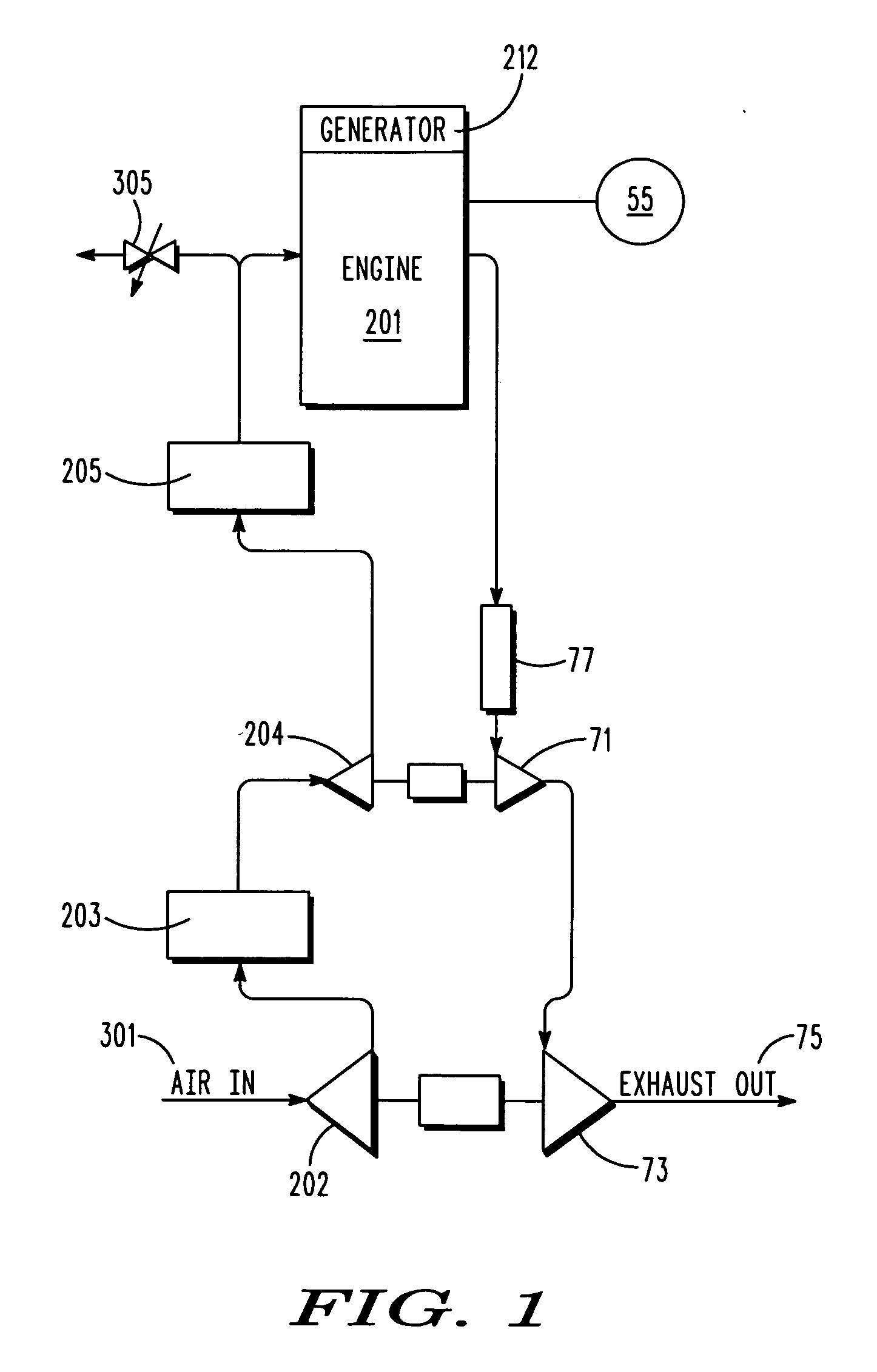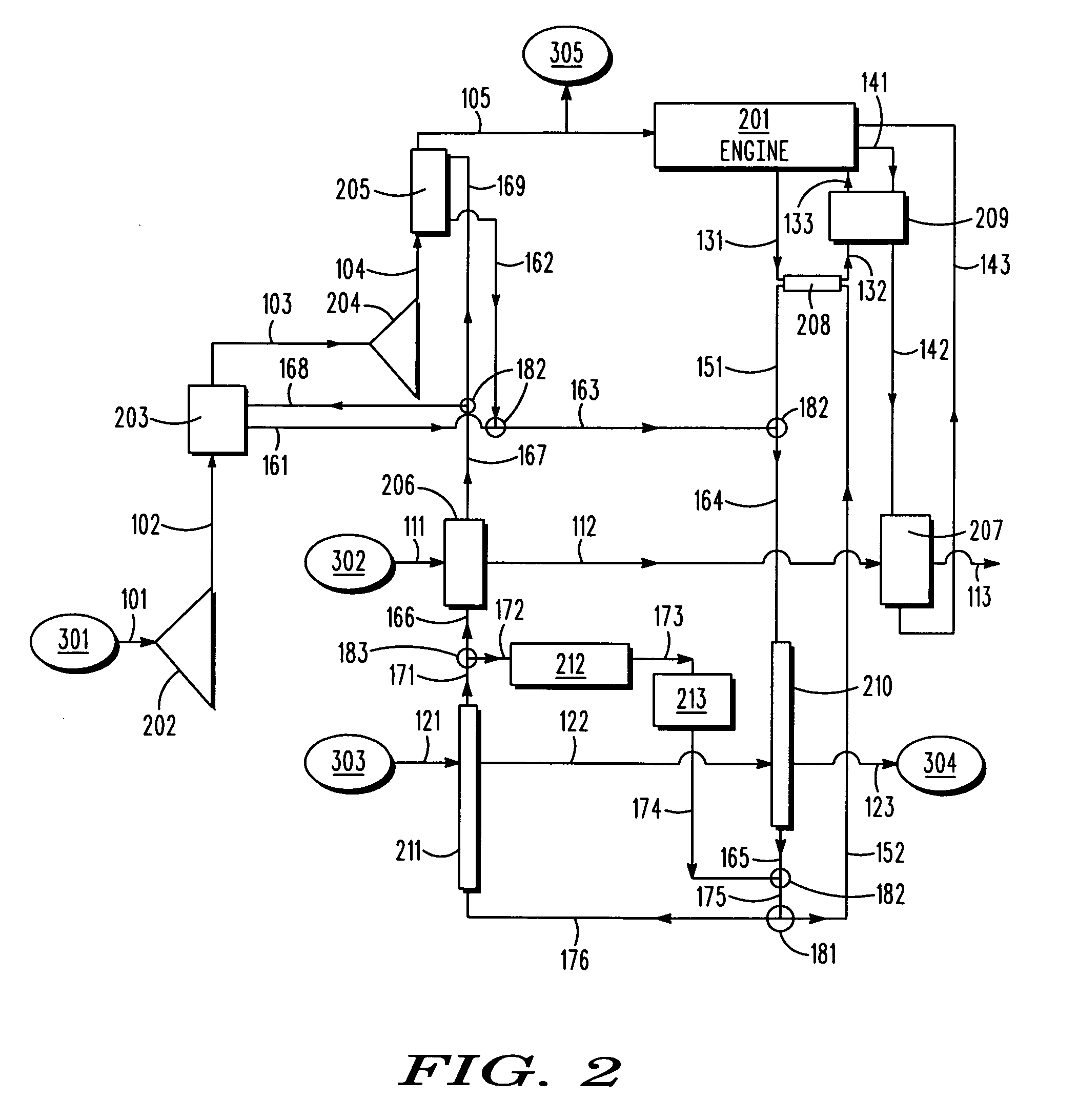Cold fuel cooling of intercooler and aftercooler
a technology of intercooler and cold fuel, which is applied in the direction of machine/engine, combustion-air/fuel-air treatment, turbine/propulsion fuel heating, etc., to achieve the effect of reducing the corrected mass flow, reducing the power needs and/or the size and weight of the engine, and reducing the pressure required
- Summary
- Abstract
- Description
- Claims
- Application Information
AI Technical Summary
Benefits of technology
Problems solved by technology
Method used
Image
Examples
first embodiment
[0029]With reference to FIG. 1, the powerplant of the first embodiment includes a power generation system including an internal combustion piston engine 201 that drives a generator 212. In alternative embodiments the power generator could be an engine that directly drives a mechanical system such as a propeller system, or a fuel cell. The powerplant also includes a control system 55 configured to control the operation of the powerplant over an envelope of operating conditions (e.g., over a range of power generation requirements), over a range of operating conditions (e.g., temperatures and pressures throughout the powerplant), and over a range of ambient conditions that can range from sea-level temperatures and pressures to stratospheric conditions.
[0030]As an oxidizer, the engine uses ambient air received in a first air scoop 301, and that is first compressed in a first-turbocharger compressor 202 and cooled in an intercooler 203, and then compressed in a second-turbocharger compre...
fourth embodiment
[0057]In the invention, the second hydrogen heater is integrated into the primary cooling network, and the third cooling network is thermally isolated from both the primary cooling network and the second cooling network. More particularly, with reference to FIG. 4, the second hydrogen heater 207 is integrated into the rear-ram-air heat exchanger input passageway 164, and is thereby adapted to use hydrogen that has been once cooled by the first hydrogen heater 206 to cool coolant from the intercooler 203, the aftercooler 205, and the engine-coolant heat exchanger 208. Additionally, the coolant-oil heat exchanger 209 has been eliminated. Also, a bypass 191 has been provided to allow adequate hydrogen heating at the first hydrogen heater 206 when the intercooler 203 and aftercooler 205 only require a slow flow of coolant.
fifth embodiment
[0058]With reference to FIG. 5, in the invention, a highly cooled payload device 214 such as a low temperature sensor requires cooling using a below-ambient temperature cooling fluid. The ultra-chilled compressor-cooler coolant passageway 167 becomes the split-off point for a separate coolant loop that passes ultra-chilled compressor-cooler coolant through the highly cooled payload device 214, which includes an integral heat exchanger configured to cool the device, and then back into the existing passageways at some temperature-appropriate passageway location, such as the hot compressor-cooler passageway 163. In a variation of this embodiment, the separate coolant loop passes ultra-chilled compressor-cooler coolant through the highly cooled payload device 214, and then back into the existing passageways at a cooler location, such as the once-heated additional-source passageway 173 (see FIG. 6).
Some Aspects of the Embodiment
[0059]With respect to FIGS. 1-6, the first hydrogen heater 2...
PUM
 Login to View More
Login to View More Abstract
Description
Claims
Application Information
 Login to View More
Login to View More - R&D
- Intellectual Property
- Life Sciences
- Materials
- Tech Scout
- Unparalleled Data Quality
- Higher Quality Content
- 60% Fewer Hallucinations
Browse by: Latest US Patents, China's latest patents, Technical Efficacy Thesaurus, Application Domain, Technology Topic, Popular Technical Reports.
© 2025 PatSnap. All rights reserved.Legal|Privacy policy|Modern Slavery Act Transparency Statement|Sitemap|About US| Contact US: help@patsnap.com



